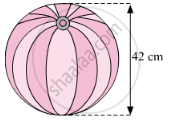Advertisements
Advertisements
प्रश्न
As shown in the figure a cubical block of side 7 cm is surmounted by a hemisphere. Find the surface area of the solid.

उत्तर
Side of a cube (a) = 7 cm
Radius of a hemisphere (r) = `7/2` cm
Surface area of the solid = T.S.A of the cube + C.S.A of the hemisphere – Area of the base of the hemisphere
= `(6 xx 7^2 + 2 xx 22/7 xx (7/2)^2 - 22/7 xx (7/2)^2)"cm"^2`
= `(294 + 77 - 77/2)"cm"^2`
= `(294 + 77/2)"cm"^2`
= 332.5 cm2
APPEARS IN
संबंधित प्रश्न
Water flows at the rate of 15 m per minute through a cylindrical pipe, having the diameter 20 mm. How much time will it take to fill a conical vessel of base diameter 40 cm and depth 45 cm?
A farmer connects a pipe of internal diameter 20 cm from a canal into a cylindrical tank which is 10 m in diameter and 2 m deep. If the water flows through the pipe at the rate of 4 km per hour, in how much time will the tank be filled completely?
Find the surface area and the volume of a beach ball shown in the figure.

A tin maker converts a cubical metallic box into 10 cylindrical tins. The side of the cube is 50 cm and the radius of the cylinder is 7 cm. Find the height of each cylinder so made, if the wastage of 12% is incurred in the process `(pi = 22/7)`
A vessel is in the form of a hemispherical bowl mounted by a hollow cylinder. The diameter is 14 cm and the height of the vessel is 13 cm. Find the capacity of the vessel
From a solid cylinder whose height is 2.4 cm and the diameter 1.4 cm, a cone of the same height and same diameter is carved out. Find the volume of the remaining solid to the nearest cm3.
A right circular cylinder just encloses a sphere of radius r units. Calculate the ratio of the areas of the sphere and cylinder
A hollow metallic cylinder whose external radius is 4.3 cm and internal radius is 1.1 cm and the whole length is 4 cm is melted and recast into a solid cylinder of 12 cm long. Find the diameter of a solid cylinder
Suppose we have block of 4 kilogram kept on a horizontal surface and we are applying a horizontal force of 10 newton. Let the coefficient of friction is 0.2. Find the force of friction. Assume that g = 10.
An ice cream pot has a right circular cylindrical shape. The radius of the base is 12 cm and the height is 7 cm. This pot is completely filled with ice cream. The entire ice cream is given to the students in the form of right circular ice cream cones, having a diameter of 4 cm and a height is 3.5 cm. If each student is given one cone, how many students can be served?
